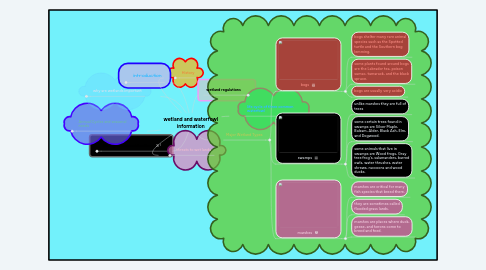
1. History
1.1. one point in time Michigan was about a third or more covered in wetland habitats.
1.2. animals such as bear sized beavers, mastodons, caribou. these species diapered and where replaced with more today like ones.
1.3. draining wetlands for agriculture and development was the main lose of of wetlands.
2. Management considerations
2.1. mow grass between July 15 and August 30 to minimize nest disturbance.
2.2. monitor the wetland for invasive aggressive plants.
2.3. restore any wetlands you have found.
3. Annual Cycles and seasonal needs
3.1. a waterfowl will bond with a mate in the winter, in spring they migrate, breed, nest, and rear their blood, and in the summer they molt, and in fall they migrate again.
3.2. the molting cycle takes about three to five weeks.
4. why are wetlands important
4.1. Michigan boasts about 2300 native plant species and 50% of those are wetland species. and more than 25% of wetland species are endangered or threatened.
4.2. for animals we have 10 to 15 of the 66 mammals, 180 of the 370 birds, 22 of the 28 reptiles, and all of the 23 amphibians can live in wetlands.
5. introduction
5.1. Many people love to visits wetland areas just to view these birds.
5.2. wetlands are the most important habitat for waterfowl species.
5.3. wetland's help reduce floods
5.4. The number size of wetland's in Michigan has greatly decreased
6. threats to wet lands
6.1. river channels grow which overflow the wetlands.
7. wetland regulations
7.1. construction in, over and under navigable waters is not allowed.
7.2. Michigan is estimated that 35% of the original 11 million acres of wetlands have been drained or filled.
8. life cycle of three common waterfowl
8.1. wood ducks
8.1.1. they arrive in Michigan from the southern wintering areas in march
8.1.2. they leave into a forest where they feed on acorns and aquatic seeds.
8.2. mallard
8.2.1. the babys are able to fly in 50 to 60 days.
8.2.2. they lay one egg everyday for about 9 to 10 days until the clutch is complete. then she will incubate them for about 25 days.
8.2.3. they make there nests around 500 ft away from wetlands
8.3. blue-winged teal
8.3.1. they like seasonally or temporarily flooded shallow wetlands.
8.3.2. they lay about 10 eggs then they incubate for about 23 days.
9. Major Wetland Types
9.1. bogs
9.1.1. bogs shelter many rare animal species such as the Spotted turtle and the Southern bog lemming.
9.1.2. some plants found around bogs are the Labrador tea, poison sumac, tamarack, and the black spruce.
9.1.3. bogs are usually very acidic
9.2. swamps
9.2.1. unlike marshes they are full of trees
9.2.2. some certain trees found in swamps are Silver Maple, Balsam, Alder, Black Ash, Elm, and Dogwood.
9.2.3. some animals that live in swamps are Wood frogs, Gray tree frog's, salamanders, barred owls, water thrushes, water shrews, raccoons and wood ducks.
9.3. marshes
9.3.1. marshes are critical for many fish species that breed there.
9.3.2. they are sometimes called flooded grass lands.
9.3.3. marshes are places where duck, geese, and herons come to breed and feed.

